
December 18th, 2013
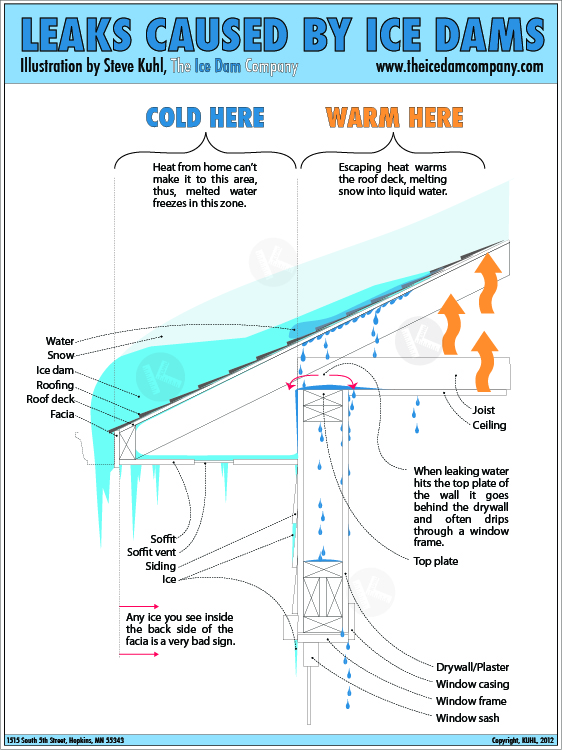
Best rated ice dam removal in minneapolis
I’ve been working on a new graphic to describe the basics for homeowners in Minneapolis to identify a problematic ice dam. It’s true that some ice dams cause no problems. The key consideration in determining whether or not an ice dam is a current problem is all about where you see ice. Study this drawing closely and you will see that any ice behind the facia is a bad sign. Ice through the soffit, down the exterior wall or through the window frame is very bad thing. Leaks caused by ice dams minneapolis
Tags: about ice dams, best ice dam removal in minneapolis, best rated ice dam removal contractor, gutter ice, highest rated ice dam removal company in minneapolis, how do I know I have ice dams, how to tell if an ice dam is a problem, ice dam prevention, Ice dam removal, ice dam removal jerks, identifying an ice dam, is my ice dam bad, Roof Leak, signs of an ice dam problem
Posted in Ice Dams, Misc.
December 13th, 2013
We received a call yesterday that was odd, even by our standards. The other strange part is that it was the second call in two days about the same issue. The homeowner noticed a bad smell coming from the shower and sink drains in her home in multiple locations. Moreover, there was a gurgling noise coming from the drains when the toilet flushed or when the other fixtures were used. The smell was so bad these poor people had to leave their homes. It was the smell of raw sewage, which ranks up there with the rankest of rank. Bummer indeed.
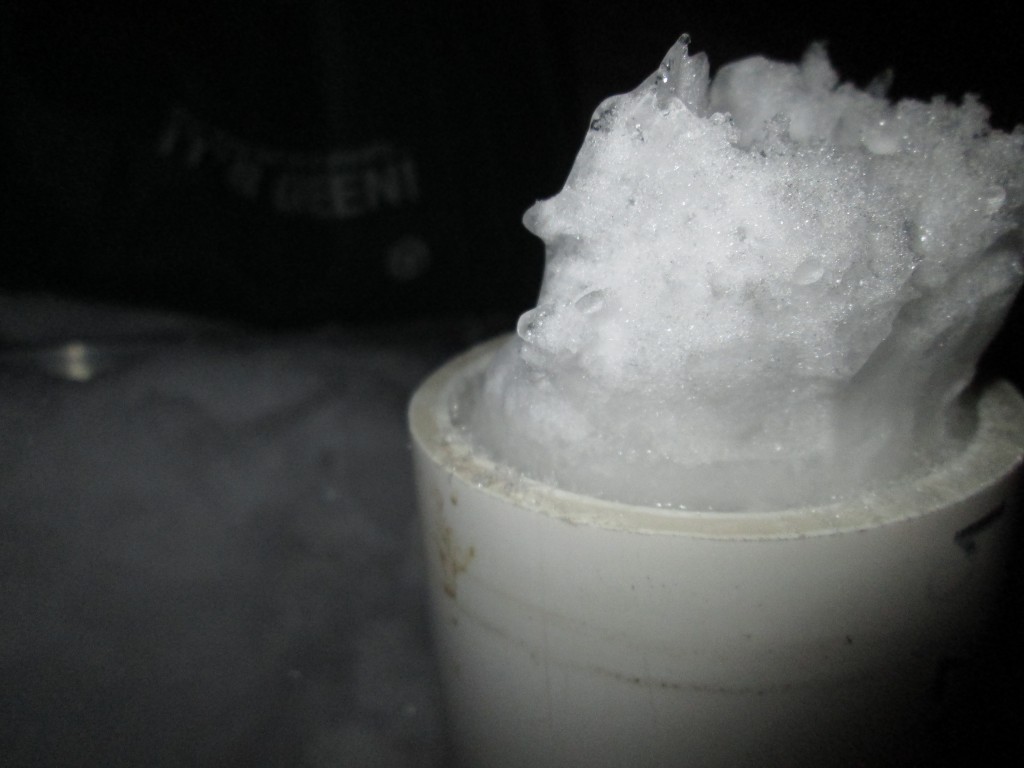
Plumbing vent plugged up with ice and snow
We sent one of our guys over there at 8pm in the dark to fix the issue because we felt so bad for these people. They had kids and the whole family was living at Grandpa’s house until the smell was figured out. Usually snow that falls on top of PVC plumbing vents just falls in and melts somewhere inside the system. In this case it piled up and formed a solid chunk of ice that completely blocked the pipe. We used a heat gun to quickly dislodge the ice and the problem was solved. We still can not figure out why this happened in the first place. Theoretically this could happen on every home in Minnesota but it doesn’t. We will be puzzling over this case for a while.
Tags: ice dam removal edina, ice dam removal jerks, lake minnetonka ice dam removal, minnepolis ice dam removal, orono ice dam removal, twin cities ice dam remover, wayzata ice dam removal
Posted in Ice Dams, Misc.
February 21st, 2013
We came across an article giving a basic overview of ice dams on About.com. One particular part of the article rang out in familiar tones:
Rows of icicles along the roof of a house look very pretty but they are often a symptom of an ice dam. An ice dam is caused by snow melting from the roof of a house, but then freezing in the gutters creating a dam. (our emphasis)
Read About.com’s Minneapolis Ice Dam Article
It’s a common misconception that gutters are somehow a required ingredient to the ice dam recipe. It’s understandable why this falsehood perpetuates: a gutter is a basin that will catch running water, it’s typically a metal-material so in cold it conducts low temperatures, and gutters live on the edge of the overhang, where ice dams form. –But it’s not explicitly why they form.
Why do Ice Dams form then?
The temperature in your attic should be as close to the temperature outside as possible, but when heat escapes your house, snow on your roof can melt. Even when your attic houses a higher temperature then it should (you have some home performance issues), when that melted water on your roof gets to the overhang, it can refreeze, because there’s no heat source directly below it.
See the following illustration, and also check out Our Definitive Guide on Ice Dams:

Looking at the illustration, you can see we aren’t even showing a gutter, and it’s definitely not uncommon for an ice dam to form in this situation.
Although gutters are not a requirement for an ice dam to form, and having no gutters is not an ice dam prevention solution, gutter ice can cause major damage, simply because of the way a gutter attaches to the overhang facia, and can collect a lot of weight in ice.
If you have problems with ice dams, or require ice dam removal contact the Ice Dam Company today.
If you have a leak as the result of an ice dam, we can help there too.
Tags: about ice dams, gutter ice, ice dam removal jerks
Posted in Ice Dams, Misc.
February 19th, 2013
Another ice dam removal method-round-up by Reuben, this time in the Star Tribune:
Hack Method of Ice Dam Removal Discussed
At the end of the article Reuben give Ice Dam Company a little screen time where Steve talks about the differences between a true ice dam steamer and high-temperature pressure washers.
Tags: Ice dam removal, ice dam removal jerks, minneapolis ie dam removal, steamer, twin cities ice dam remover
Posted in Ice Dam Removal
January 31st, 2013
This past week, we were called out to a Fairview Hospital to resolve an ongoing roof leak in their EPDM roof or rubber roof. The roof leak, they suspected, was being caused by an massive ice build up on their flat roof. The area covered in ice was approximately 1200 square feet and ranged between 3-5″ thick. They had gotten another bid from acompetitor to remove the entire ice field for around $8,000.
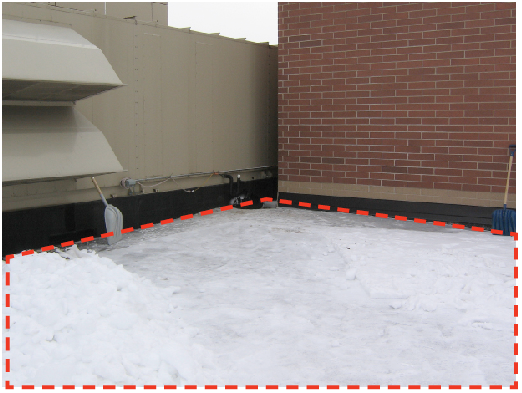
Upon visiting the site, we quickly determined it was not necessary to remove the entire ice field in the area. Our experience as professional roofers and our use of thermal imaging quickly pointed us to a bad corner flashing detail as shown here. This area was completely covered by ice and was the main source of their leak.

The job was quite simple. We used our commercial steamers to cut through the ice and clear a channel from the area around the leak to the nearest roof drain. This allowed any melted snow/ice to run directly to the drain, instead of being dammed up and leaking into the hospital.
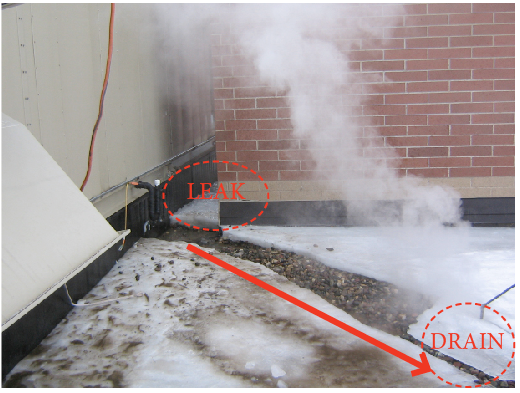
We also removed a the large section of ice that surrounded the leak area to allow for proper repair of the roofing and flashing that had failed. Fairview was so happy with our work that they ended up having us remove rest of the ice in that surrounding area. In the end, our cost for all of the work was half that of our competitor’s estimate. We pride ourselves in doing business under the philosophy that we’re trying to build lasting, honest relationships. Not just trying to earn the quick buck. Our guess is that we will be called for all ice removal needs by the Fairview Hospital network going forward. A lot of ice removal companies in the Minneapolis area are allergic to honesty. Perhaps Fairview has an ointment for that?
Tags: edina ice dam removal, ice dam removal jerks, minneapolis ice dam removal, wayzata ice dam removal
Posted in Ice Dam Removal, Water Damage
January 15th, 2013
Minnesota and the Twin Cities are having another lighter snow season this year. We are on pace to be well below our average snowfall of about 50″ of snow per winter. When there’s less snow there generally are less ice dams to remove, though snowfall isn’t the only factor that contributes to ice dams forming. Elsewhere there has been more snow that is causing ice dam problems, and we’d thought we’d do a quick round-up of the current status of ice dam formations accross the counrty.
Our Neighbors
Wisconsin has gotten quite a bit more snow then we have, and ice dams are in the news lately.
More than two weeks after the blizzard that paralyzed southern Wisconsin, homeowners may be paying for its effects — broken, snow-heavy limbs and ceiling-spotting ice dams — far into the spring.
Full article From the Wisconsin State Journal About Ice Dams
We found this bit in an article in the Sauk Prairie Eagle about Ice Dams quoting a contractor dealing with Ice Dams in Wisconsin to be fundimentally flawed:
“When there is 10 inches of snow, it’s critical you remove snow from the bottom three to four feet of your roof”
We know from our extensive experience with ice dam removal and ice dam prevention that removing only the bottom 4 feet of snow from your roof doesn’t always solve the problem. In fact, assuming it has solved things can set you up for double the disappointment. Because Ice dams can still form, and even take on a more damaging form. See our case study on “Double Dams”.
The East
The northeastern region of the US is typically a hotbed for ice dams. Where they generally don’t have the persistant double-sub-zero digit temps for as long as Minnesotas does, they make up for in in the amount of snowfall. The Title of this article from the Press Republican makes the genius assertion: “Ice Dams Contribute to Roof Leaks”, and we think they’re onto something there. Then there’s this article from the Booth Bay Register about preventing ice dams that also has the distinction of having the worst ice dam graphic we’ve seen in a while. We don’t mean to poke fun. Not everyone is as geeky about ice as we are.
Posted in Ice Dams: General Info
January 3rd, 2013
An article in popular mechanics recently published about Ice Dam Prevention, and What to do if you have ice dam problems gets the basics:
To prevent an ice dam, don’t heat the roof, keep it cold. That way, the snow on the roof eventually dissipates without making large amounts of meltwater. The underside of the roof deck should not exceed 30 F. The best way to maintain low temperatures is by ensuring that there is adequate insulation and sealing gaps that let warm air pass into the attic from the house. The attic must also be ventilated, so that cold air is introduced into it and heated air escapes rapidly. Some remodeling contractors are under the impression that heat passing through the attic helps prevent ice dams, when just the opposite is true. Although excess heat moving from the attic through the roof rapidly melts snow, once the meltwater touches the cold eaves, it quickly freezes and forms an ice dam.
Read the full Popular Mechanics Ice Dam Article Here
…Then the article falls short at really looking at solutions to identify root problems (other then proper insulation) and determining solutions. Instead it looks at situations where there’s a furnace in the attic, and then turns it’s focus to cosmetically hiding symptoms of ice dams. Before you go this route, you really should determine what the underlying problem is, and fix it.
If you don’t feel confident in attempting to diagnose and fix ice dam problems yourself, it’s always a good idea to contact a contractor that has a Minnesota State Certified Energy Auditor on staff, has experience in insulation & ventilation installs, fixing roof leaks and making stuff look good.
Tags: edina ice dam removal, ice dam removal jerks, minnetonka ice dam removal, orono ice dam removal, wayzata ice dam removal
Posted in Ice Dams, Misc., Water Damage
December 20th, 2012
Our friend Reuben Saltzman at Structure Tech did a nice round-up of ice Dam prevention general knowledge, with examples he’s come across while inspecting homes in the Minnesota winter.
Minnesota got dumped on this weekend with nearly fifteen inches of snow in some areas. With hardly any snow last winter, we almost forgot what a real snow storm looked like. I haven’t heard about any concerns over ice dams yet, but I suspect they’ll be coming very soon. The perfect conditions for ice dams are large amounts of snow and temperatures in the teens and twenties, which is what we’re expected to have this week.
Read the Full Post: How to Prevent Ice Dams
Tags: edina ice dam removal, edina ice dams, ice dam removal jerks, minneapolis ice dam prevention, orono ice dam removal, wayzata ice dam removal
Posted in Ice Dam Prevention
December 18th, 2012
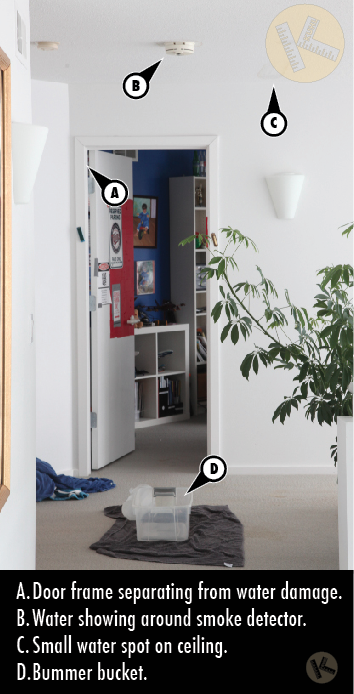
Here is what a leak from an ice dam looks like.
Ice dams cause leaks in Minneapolis homes but not usually until later in the ice dam season. I received a call earlier today from a client in Edina with water pouring through her ceiling. The water was coming through a smoke detector (B) and soaking her floor. One interesting but not entirely surprising thing was that the water affected a much larger area than was obvious from below (also showed at location C). Slight cracking in the door frame also indicated water problems (B).
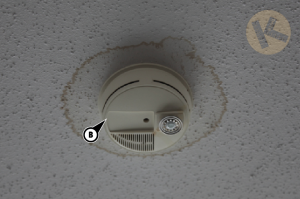
When I looked up I notice a ring of discoloration around the smoke detector (seen in photo, above). The thermal imager revealed a 6′ x 6′ area of wetness around the smoke detector. The client had a hard time understanding why the water had not shown in a larger area until I explained how her ceiling assembly worked. Because there was unconditioned space above the drywall there was also a code required vapor barrier, i.e, plastic sandwiched between the drywall and the ceiling framing. When the ice dam above caused water to back up and leak into the home it collected on top of the ceiling until it found the path of least resistance in the vapor barrier. In this case that was a smoke detector but it is often a light fixture, a vent or a seam in the plastic itself.
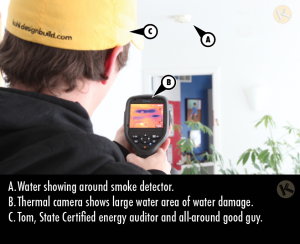
Ice dam removal in Edina
A quick look at the thermal image shows a large dark purple area (photo left, point B). This is wetness that has not yet manifested visually from below. It is damage nonetheless and should be repaired.
We take immense pride in being industry leaders in ice dam prevention, insulation and ice dam removal. There isn’t another ice dam removal company in town that has thermal imaging technology in-house or guys like Tom, who are certified geeks in all things relating to home performance technology.
Tags: ice dam removal jerks, Roof Leak, thermal inspection, water damage
Posted in Water Damage
January 20th, 2011
Okay, I have have seen it all now. I’ve kept quiet for the last two years but I can’t do it any longer. I just spoke with a woman whose roof was scarred up by a ‘professional’ using a ‘steamer’. The only catch was that the guy wasn’t using a steamer; it was a pressure washer . A number of companies are using high-temperature pressure washers instead of steamers to remove ice from homes. At first glance it might sound like a distinction interesting only to ice geeks. But alas, it is a pretty big deal. In short, pressure washers rely on pressure to remove ice (go figure), not on heat. ‘High-Temperature’ pressure washers operate at slightly higher temperatures than a typical water heater (120-170 degrees). A steamer is an entirely different machine. It converts cold tap water into true steam, which can only be achieved at 250 to 300 degrees. Again, why care? In short it comes down to the fact that steam remove ice much, much faster than high-pressure water. This translates in to time and money (less of both if you use a steamer). Steamers are not only the fastest choice, they are the safest. It doesn’t take a genius to understand that using high-pressure water near frozen roofing materials may not be the best plan. Invariably, regardless of the user, such machines strip off the granules on asphalt composite shingles. This voids manufacturers warranties and it reduces the lifespan of the shingle.
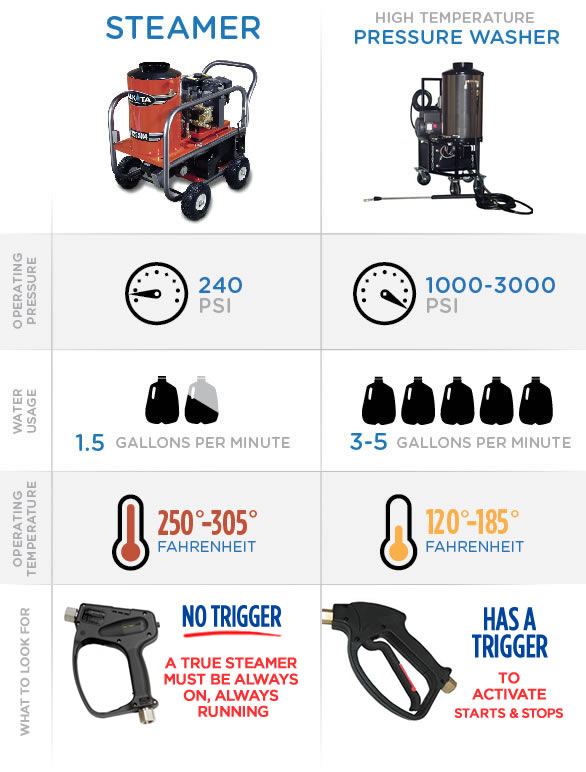
We own three high-temp pressure washers but would never consider using them to cut ice. To the average dude they don’t look much different than a steamer. Use one to cut ice and the difference becomes clear right away. For this reason, conscientious, ethical contractors use actual steamers. Besides The Ice Dam Company, there are a number of outfits in town that use true steamers, including Garlock-French and Absolutely Clean Window Washing. I’ve been around this industry for over 20 years and I have never heard a complaint about those shops. My point is, no matter who you hire to remove your ice, make certain their machinery is as advertised. It must be running at a minimum of 250 degrees over the entire course of the job to function safely and efficiently.
Here’s a great image taken by out friend Reuben Saltzman of Structure Tech, showing what kind of damage a pressure washer can do to an asphault roof when it’s used to remove an ice dam:
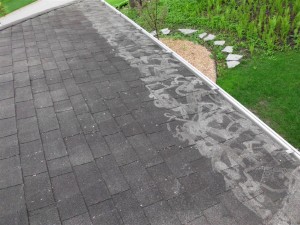
Oops.
Tags: edina ice dam steaming, Ice dam removal, ice dam removal jerks, minnetonka ice dam steaming, orono ice dam removal, roof ice steaming
Posted in Ice Dam Removal

















